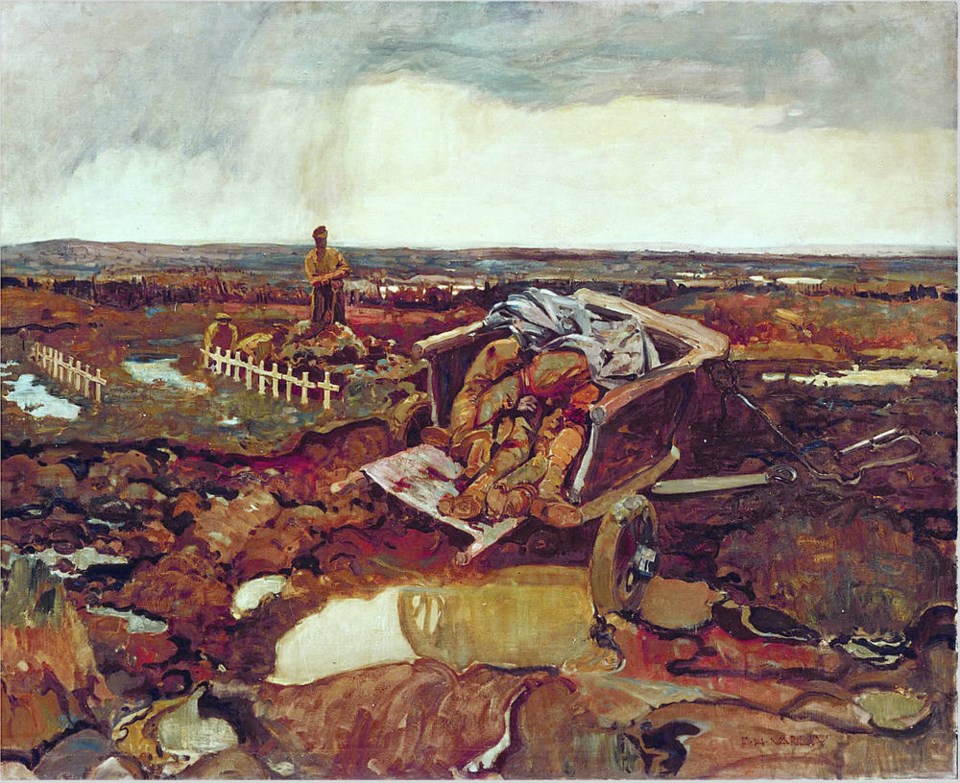Many people feel a bit of trepidation when talking about art, but don’t be intimidated by art! Art may invigorate you, change your thoughts, even disgust you or make you roll your eyes. At times, it provokes the most common comment: “I don’t get it,” or “I could do that.”
But art should never make you feel inferior or unintelligent — if you don’t get it, it’s not your problem. It’s nobody’s problem — it’s not even a problem. Whether you buy an inexpensive piece from HomeSense or an expensive piece from a fancy high-end gallery, if you like it, that’s grand.
My parents were Second World War “war artists,” that is, they were part of a group of Canadian painters in the army who were especially chosen to go overseas and paint the scenes of war that they observed. Their art became the property of the Canadian government and is now housed in Ottawa, both in the Canadian War Museum and the National Gallery.
My mother, Molly Lamb Bobak, was the only female war artist and that’s how she met my father, Bruno. Dad told me that he was “forced” to share a studio with the only woman painter (but obviously it worked out because here I am, and I resemble both of them).
If you would like to see some wonderful selections of war art, pick up a copy of the beautiful, profoundly moving book Canvas of War by Dean F. Oliver and Laura Brandon (Douglas and McIntyre, 2000). Mum’s favorite painting from the war (albeit, sadly horrifying) was by Fred Varley and is on page four. It was titled For What? – and what a wonderful title for such a tragic subject.
Although I grew up surrounded by art and artists (some very eccentric!) and was dragged to every art exhibit in Canada, I know no more than anyone about the personal meaning of art to each of us. Looking at art is a very private journey, and if you would like to learn more and experience what art may do for you, how it can enhance or alter your feelings, opinions and knowledge, I recommend these books.
Mythic Beings, Spirit Art of the Northwest Coast by Gary Wyatt (Douglas and McIntyre, 1999) is a superb collection of beautifully photographed works by 34 First Nations artists. Each image includes a text in the form of an oral history, a spiritual story or myth by the artist.
For example, the artist Ken McNeil’s alder and goat hair mask titled The Wind depicts the merging of four winds, each representing a distinct personality, or Raven’s Eye by one of my favourite contemporary Indigenous artists, Susan Point. Created from yellow cedar, kiln-cast glass, mirror and paint, the piece represents, in Point’s words, “looking backward and looking forward …”
The selected exquisite work and passionate text is deeply meaningful for all of us. I cherish this book!
Wild Flowers (Royal B.C. Museum, 2006) is a delightful little collection of 21 short writings by Emily Carr accompanied by enchanting illustrations by Emily Woods, Carr’s childhood drawing teacher.
Kathryn Bridge’s excellent insightful forward tells us that Emily Carr wrote these pieces later in life (1940) while recovering from a stroke.
Carr writes of the glorious shrubbery and forest blossoms, but to us, she says: “Stick to your road of dirt oh human-shoe-of-leather, for you the smell of petrol-haste, horse manure and human sweat.” (I get it Emily!).
An excellent way to reflect upon art is to visit an art exhibit at a local gallery. (My friend Michael at the Madrona Gallery downtown loves to talk about Canadian art!) Then, if it’s available, pick up the catalogue of the work and look it over in a quiet moment at home.
One of the best book/catalogues I ever purchased was Art B.C. Masterworks From British Columbia by Ian M. Thom (Douglas and McIntyre, 2000). This is a vast and diverse selection of art that covers photography, sculpture, installations and both historical and contemporary painting from the Vancouver Art Gallery’s collection. It includes my favourite painting of Dad’s, a large oil, semi-abstract, of Vancouver Harbour (1959) — the strip of red tankers under a dusty pink sky beyond the cobalt blue water is, for me, absolutely gorgeous.
Currently, there is an art exhibit of Emily Carr’s early work, (the paintings she did in France, before her vivid, heavenly West Coast forest paintings) at the Royal B.C. Museum. The exhibit is titled Emily Carr: Fresh Seeing, and the catalogue is a stunning, colourful hardcover compilation of the displayed art.
Think of art as your private little spiritual adventure. It’s intimate, almost secretive, and may be even more valid during these current pandemic times.



